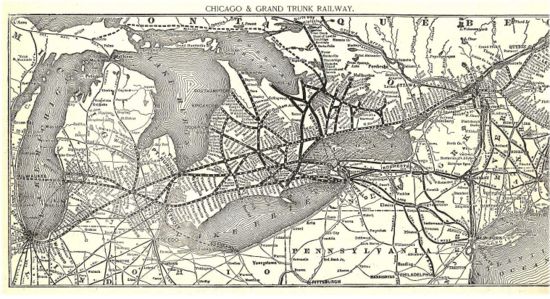Grand Trunk Railway
The Grand Trunk Railway of Canada was a railway system based primarily in Ontario and Quebec, with operations over much of Canada and neighboring parts of the U.S. Chartered in 1852, it quickly purchased five local railways to link Toronto with Sarnia on the west and Montreal on the east. London financiers funded its purchase or lease of 50 other railways, making it the world's longest road in 1869, when it provided some of the infrastructure for Canadian confederation. By the 1880s, it reached into Quebec, crossed into Maine to provide a links to the ice-free American port of Portland, and stretched into the Detroit-Chicago corridor.
It was a private company headquartered in England that received heavy Canadian government subsidies and was never profitable because of competition from shipping and American railways. Carlos and Lewis, (1995) show how it managed to survive despite serious financial difficulties during most of its first three decades. It was because the British investors accurately assessed the corporation's value and prospects, which included the liklihood that the Canadian government would bail out the railway should it ever default on its bonds. The government had guaranteed a very large loan and had enacted legislation authorizing debt restructuring. Such arrangements allowed the company to float new bond issues to replace existing debt and to issue securities in lieu of interest.
American executive Charles Melville Hays (1856-1914) joined the Grand Trunk in 1895 as general manager (and in 1909, president), based in the Montreal offices. Hays becoming the architect of the great expansion during a colorful and free-spending era. He upgraded the tracks, bridges, shops and rolling stock, but was best known for building grain elevators and elaborate tourist hotels such as the Chateau Laurier in Ottawa. Hays blundered in 1903 by building a subsidiary the Grand Trunk Pacific Railway Company some 4800 km long, reaching Prince Rupert in northern British Columbia in 1914. The very expensive subsidiary had too little traffic. Nearing bankruptcy in 1919, the system was nationalized, In 1923 the government merged the Grand Trunk, Grand Trunk Pacific, Canadian Northern and National Transcontinental lines into the new the Canadian National Railways crown corporation. The Grand Trunk lines, however, kept the distinctive name.
Bibliography
- Carlos, Ann M. and Lewis, Frank D. "The Creative Financing of an Unprofitable Enterprise: the Grand Trunk Railway of Canada, 1853-1881." Explorations in Economic History 1995 32(3): 273-301. Issn: 0014-4983
- Currie, A. W. The Grand Trunk Railway of Canada. University of Toronto Press, 1957. 556 pp, the standard history
- Hofsommer, Don L. Grand Trunk Corporation: Canadian National Railways in the United States, 1971-1992. 1995. 227 pp.
- Leonard, Frank. A Thousand Blunders: The Grand Trunk Pacific Railway and Northern British Columbia 1996 - 344 pages
Primary sources
- Canada. Legislature. Legislative Assembly. Special Committee on the Condition, Management and Prospects of the Grand Trunk. Report 1857, 263 pages online
